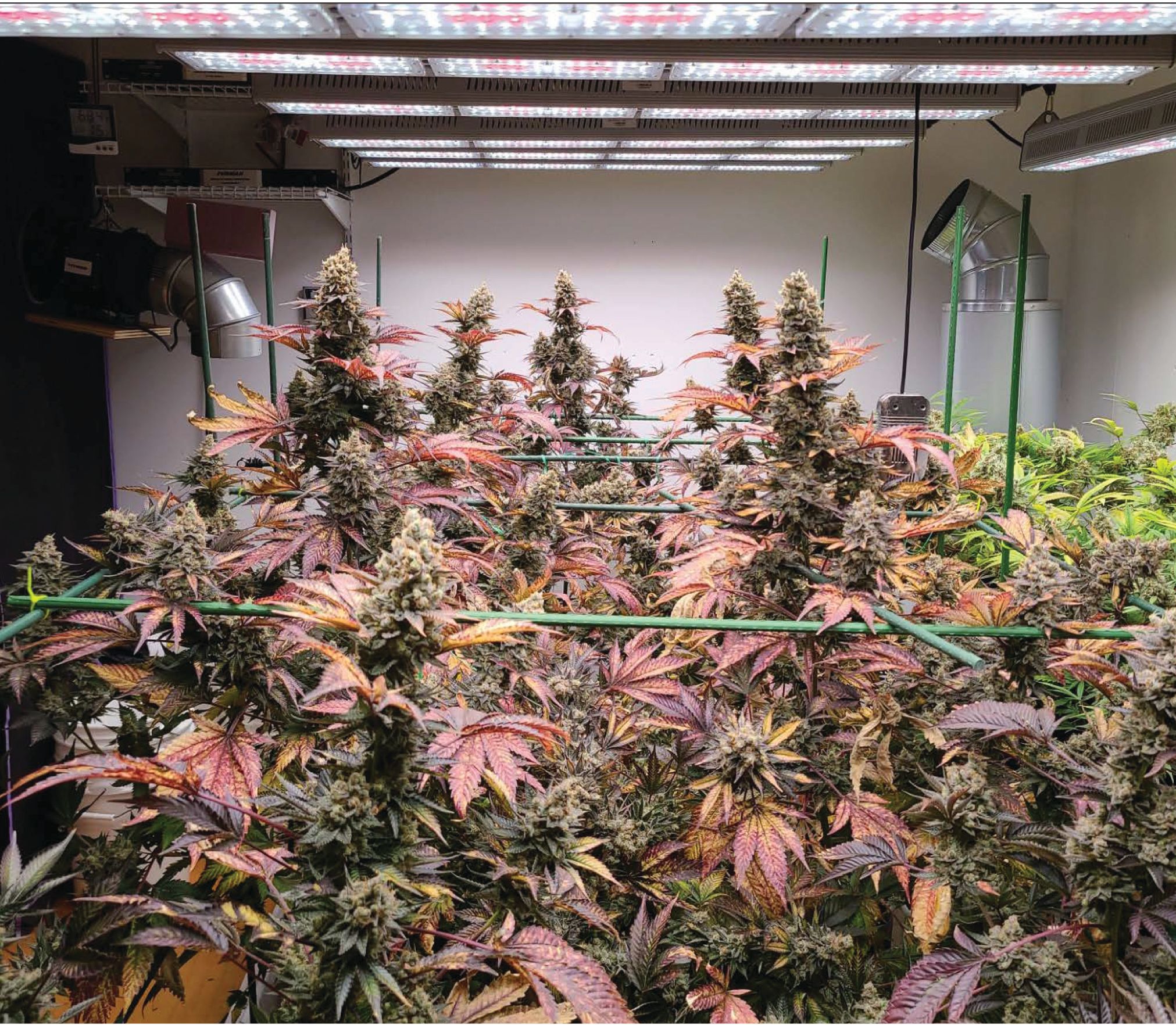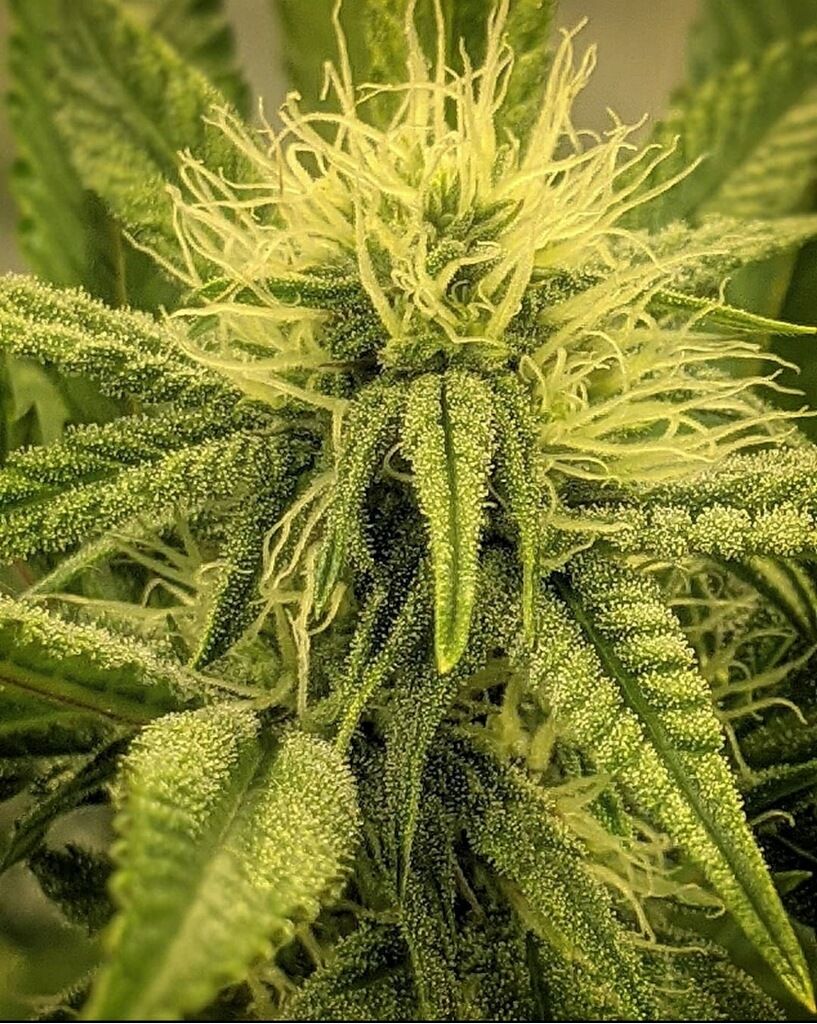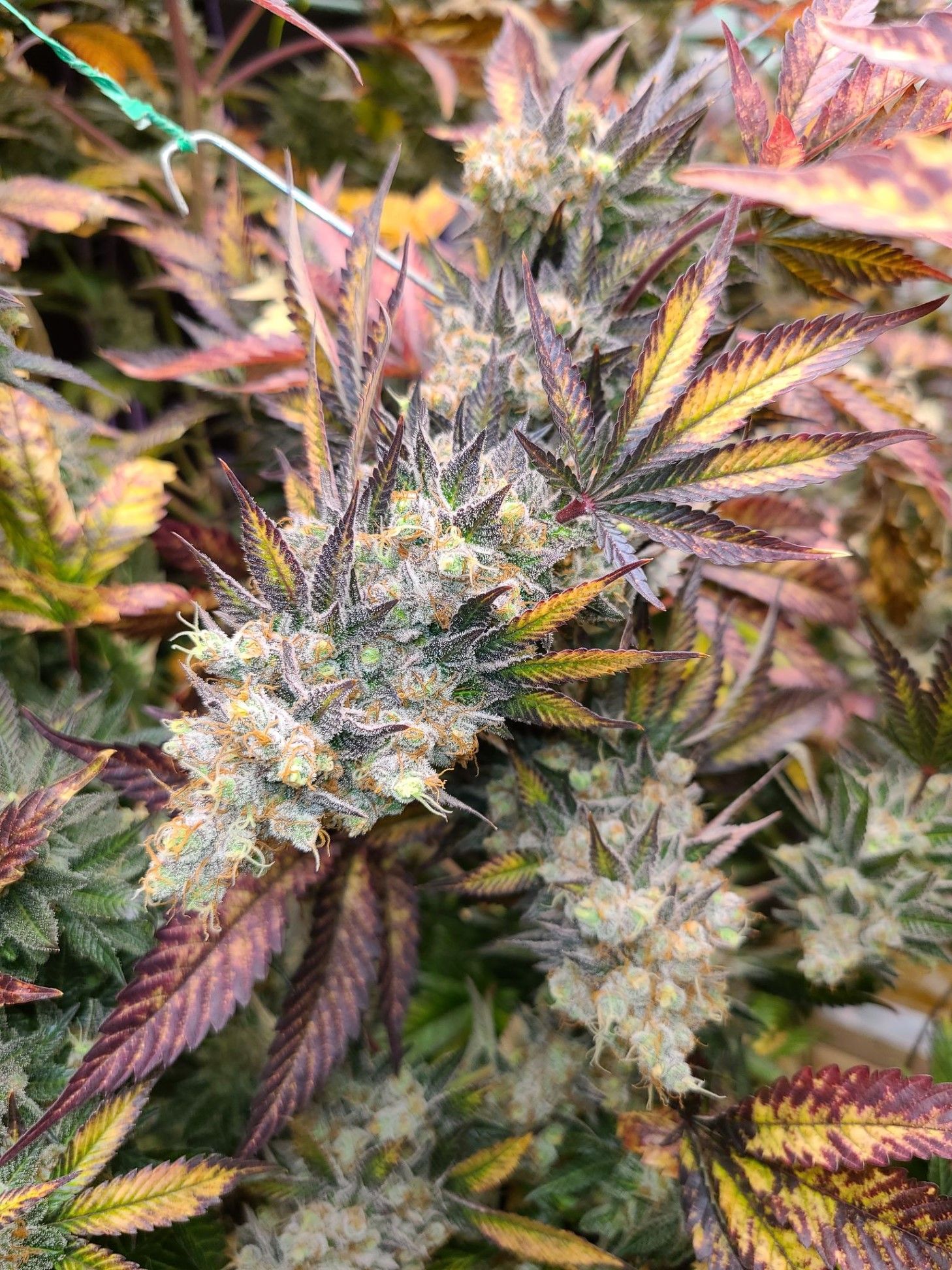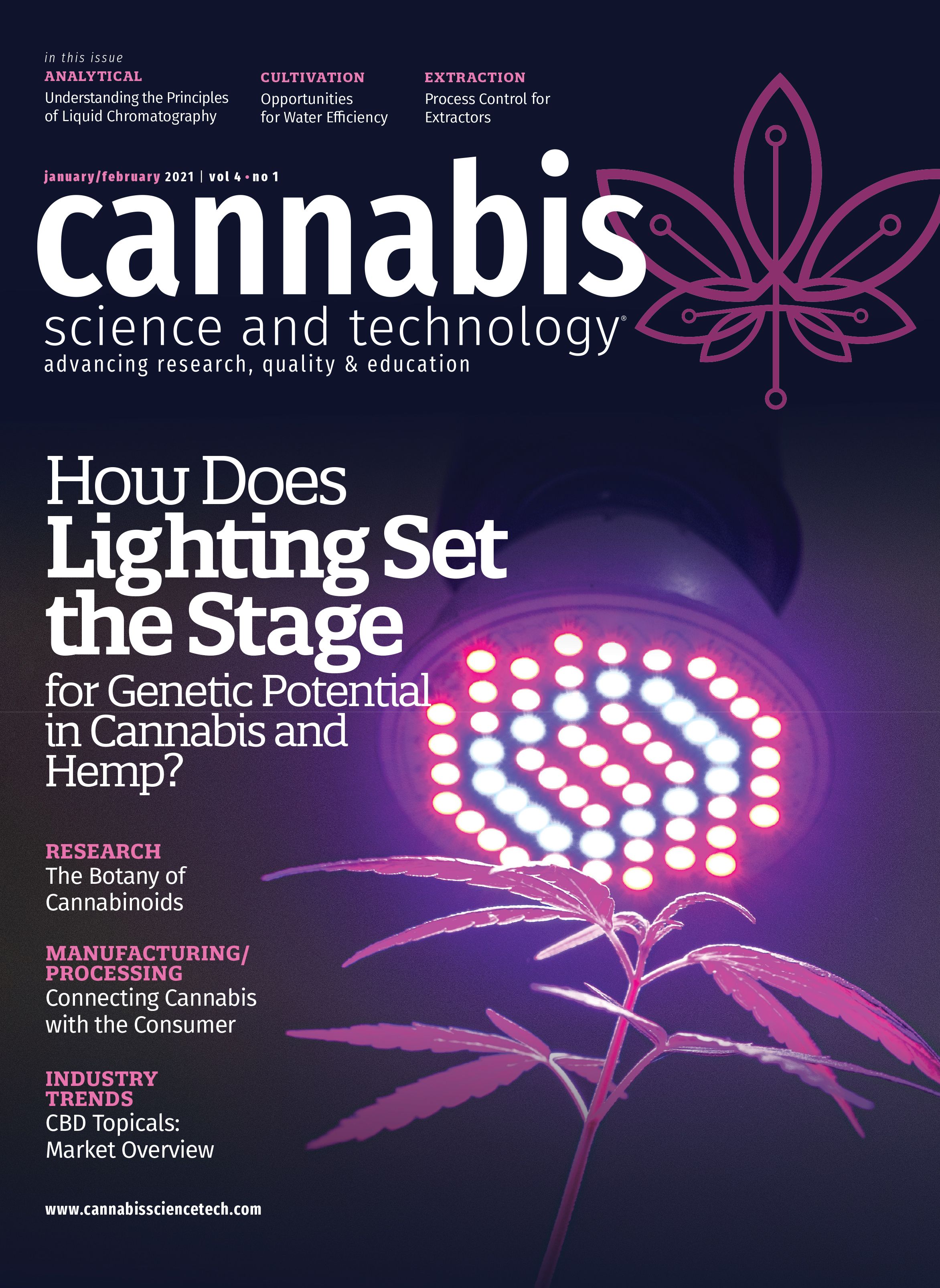Lighting: Setting the Stage for Genetic Potential in Cannabis and Hemp
Soil, water, and nutrient compositions play important roles in one’s quest to produce ultrapremium flower material; but unequivocally, it is lighting spectrum, coverage, and penetration that have the most influence over the terminal outcome, particularly in controlled environment agriculture.
robert manes and zacariah hildenbrand

In no other place do we see a more extensive interplay between nature and nurture than the new frontier of medicine: cannabis and hemp. The genetics of a given varietal certainly provide the potential for what one can expect in terms of morphological structure and phytochemical composition; however, whether or not that potential is realized is largely a function of the cultivation environment. Soil, water, and nutrient compositions play important roles in one’s quest to produce ultra-premium flower material; but unequivocally, it is lighting spectrum, coverage, and penetration that have the most influence over the terminal outcome, particularly in controlled environment agriculture.
The cultivation of cannabis and hemp is a multifaceted process that is reliant upon various genetic and environmental factors working in concert with one another to support a favorable outcome. While genetics provide a foundation for what one can expect in terms of yield and phytochemical content from any given varietal, it is likely the cultivation environment that determines whether or not the aforementioned plants achieve their genetic potential. Pertinent environmental variables include soil, water, and nutrient quality; however, lighting is likely the most influential variable in terms of producing ultra-premium flower materials.
So, what makes for ultra-premium cannabis and hemp? The most obvious answer is cannabinoids; especially delta-9-tetrahydrocannabinol (THC) and cannabidiol (CBD), the primary constituents found in cannabis and hemp, respectively. However, more recently there has been growing awareness and interest in the physiological values of the various scent and taste elements: terpenes and flavonoids.
Terpenes are organic compounds that exist in many plants, producing specific aromas, but they have uses beyond smelling great (most of them, that is). More than 100 terpene compounds have been identified in cannabis and most strains are uniquely identified by their terpene profile. From a medicinal standpoint, terpenes are responsible for certain “entourage effects” when used in conjunction with various cannabinoids. From a therapeutic standpoint, this is to say that the human body is far more responsive to a bouquet of cannabinoids and terpenes as opposed to an individual component. For example, CBD and alpha-pinene treats against inflammation while THC and beta-myrcene provides a sedative effect and relaxes muscles.
Flavonoids are polyphenolic metabolites found in cannabis and hemp that provide pigmentation and ultraviolet (UV) light filtration to the plant, and anti-inflammatory and antioxidant activity to the end user. Some of the more prominent flavonoids include the anthocyanins and the cannaflavins, which are represented as blue or purple pigments and work synergistically with various terpenes, respectively. Of the various classes of phytomolecules expressed in cannabis and hemp, the flavonoids have garnered the least amount of attention by scientists. This is likely a function of the technical difficulties associated with isolating these constituents from plant matter, as opposed to the cannabinoids and terpenes, which are contained in the extracellular trichome glands.
While terpenes and flavonoids are certainly present in cannabis grown outdoors, external environments are not conducive to the highest quality, nor the consistency of crops. Cannabis grown outdoors is subject to cross pollination from a myriad of plants, which can significantly alter chemical composition. In addition, pollination usually means that seed production begins—and seeds are a deal-breaker for cannabis patients and recreational users. How do we solve this problem? Bring them indoors and carefully control every aspect of the grow through controlled environment agriculture (CEA).
CEA requires precise control of environment, to include temperature and humidity levels, a planting medium, quality water, nutrients and additives, and of course, lighting. Of the many tools cultivators use, lighting choice is the most critical, for lighting sets the potential for plant growth and chemical content. It controls respiration and sleep cycles, provides signaling to trigger various growth stages, and powers photosynthesis.
robert manes and zacariah hildenbrand

Existing Technologies
The most common lighting used in CEA has been high intensity discharge (HID) lighting, such as metal halide (MH) and high pressure sodium (HPS). HPS is generally used for flowering stages of cannabis because it produces much more light in the amber and red end of the visible electromagnetic spectrum, as opposed to MH, which emits primarily in the blue end of this spectrum. Most HPS spectrum analysis shows that up to 95% of the power used by an HPS lamp produces output at 850 nm. We also know this as infrared-invisible to the human eye, but instead felt as heat, with little known benefit to plants. We must remove the excess heat and pay the electricity company hefty light bills, only to pump a significant portion of this output away from our grows. In addition, many HPS lamps change operating parameters as they age. After as little as 200 h of operation, their total output decreases and spectrum shifts, which is detrimental to cannabis operations. Most growers still using HPS replace their lamps every grow cycle, or every other grow cycle to counter these changes.
With the exception of growing in a greenhouse and using the sun as the main source of lighting, there are few technologies that approach the properties of sunlight for sheer power, spectrum, and coverage. Among the most promising of these technologies are light emitting diodes (LEDs).
LEDs are solid-state devices comprised of semiconductor materials, and when a current is passed through various combinations of these materials, light is produced. Many different colors of LEDs have been designed to-date, but all produce light in a very narrow frequency band. These frequencies are only a few nanometers wide and are known as “discrete” LEDs in the industry. Broad spectrum white LEDs are produced by adding a certain phosphor formula coating to a blue diode. The short wavelength and high power of the blue output causes the phosphor to fluoresce. The color of this fluorescence is derived from the specific formulation of the phosphor coating and outputs range from very blue light (also known as cool white) to light with a more reddish or orange tinge (also known as warm white).
LED lights also provide the benefit of environmental stewardship as they are far more energy efficient than other lighting modalities. In traditional HID lighting, only about 5–10% of the energy used produces light in the visible spectrum. In several of these technologies, particularly HPS and MH, there is significant output at 850 nm on the magnetic spectrum. That’s also known as infrared and, of course, we feel that as heat. LED technology gives us the ability to produce precision spectrums and lighting efficiency is approaching 24% versus the 5–10% of HID lamps.
LEDs are considered “point source” lighting, unlike lamps or bulbs that emit light (and heat) from a 360-degree envelope. This point source can be shaped very efficiently with special lenses, known as total internal reflective (TIR) lenses. These lenses collect the output from an LED and direct up to 95% of the light in a predetermined cone of light—also called a steradian.
Another benefit is the “efficacy” of LEDs versus HID lighting. Manufacturable LED fixtures can produce up to 140 lumens of light per Watt of energy consumed. The term “manufacturable” is reference to what can be sustained in everyday use. While there are LED manufacturers boasting efficacies of up to 220 lm/W, managing the heat produced is a hurdle that causes some challenges for fixture designers. Of course, there have been significant strides in thermal management materials, such as graphene composite heat sinks, but mass production will take time because of cost considerations. In contrast, the efficacy of HPS lighting is around 85 lm/W, MH is 65 lm/W, and T8 fluorescent lighting has achieved 80 lm/W.
Collectively, precision spectrum, efficiency (24%), efficacy (140 lm/W), the directional nature of LEDs using lenses, and HID fixture inefficiencies are all contributing factors to the fact that one can replace 1000 W of HID lighting with 600 W of LED lighting.
Lighting Metrics
When evaluating the various options in horticultural lighting it is best to consider three important variables: color (as in light spectrum), coverage of the crop, and using adequate power to achieve yield targets.
For color, start with the McCree Curve, researched and identified by Dr. Keith McCree in the 1970s. This describes a cross-section of 22 crop plants and their average photon utilization. Some companies are doing their own research and have developed “relative photosynthetic efficiency” maps that may help, but be sure to check the data for yourselves. The entire visible range, as well as certain spectra in the nonvisible range, should be used to produce phytochemical content and promote yield. Light in the red and far-red range assists greatly in flowering stages and helps to manipulate plant growth and development (photomorphogenesis), while light in the UV range helps with pest and pathogenic control.
Coverage is the ability to provide an average photon count across your entire crop. As previously stated, HID users are familiar with the tendency for their crops to “peak” directly under the lamp. LEDs generally provide the best coverage because of their point-source construction. Many LEDs may be placed in various configurations spreading out over a given area, as opposed to HID’s single lamp and reflector construction.
Current, or power, denotes the ability to deliver a quantity of photons to a target. Combining power and spectrum, and of course experience in the cannabis space, relative performance can be expected from certain fixtures. However, this is where things can get tricky.
robert manes and zacariah hildenbrand

Industry claims of high photon delivery can be very confusing, and even misleading. Different manufacturers' advertisements speak to lumens, footcandles, lumens per Watt, corrected color temperature (CCT), photosynthetic photon flux (PPF), photosynthetic photon flux density (PPFD), and prevailing at the time of this article, photosynthetic photon efficacy (PPE). Often the photon count is extrapolated from laboratory results expressed in lumens, lux, or footcandles—lighting metrics not particularly well-suited to horticulture. In addition, the testing is often conducted in an enclosed “integrating sphere,” or using a goniophotometer, neither of which is strictly suited to horticultural illumination testing. Some lamps are tested bare-LED or bare-bulb and some are tested within a lighting fixture. Some fixtures may employ optics, such as glass covers, lenses and reflectors, that will be delivered installed in the final product. Some glass and lenses can attenuate output by up to 8%, while some reflector assemblies can reduce light delivered to your plants by up to 40%. Certain glass completely blocks UV-A and most UV-B. It is obvious there are many variables and more often than not, vendors and manufacturers do not provide the details of their testing methods or specific metrics used to establish their “photon count.” PAR maps presenting actual photon counts at a given distance over a specific test area can be a nice metric, but PAR does not specify spectrum. For example, 50 bright flashlights can provide the light output of a 600 W HPS fixture and the PAR mapping would be phenomenal, but you wouldn’t grow a plant with it.
Corrected Color Temperature
Corrected color temperature (CCT) is expressed in degrees Kelvin, that is, 4000 °K CCT. There is still evidence that this metric is being used by vendors and manufacturers to sell product. This is perhaps one of the most useless metrics when it comes to horticultural lighting. CCT references the human eye’s perception of color and there are 100 ways to create 4000 °K, many of which won’t help in the grow room.
Photosynthetic Photon Flux
Photosynthetic photon flux (PPF) measures composite or total photon count from a source. It is usually tested in the spectral range of PAR (photosynthetically active radiation), which is currently accepted as 400–700 nm, which also happens to be the visual range of the human eye. Many researchers have proven that plants react photosynthetically outside these parameters. For instance, a chlorophyll “antenna pigment,” known as chlorophyll F, is reactive at 780 nm, far outside the visual range of humans. PPF is less useful than referencing l m/W figures, as lumens per Watt is a well-defined metric. However, neither is incredibly useful for determining efficacy or quality of lighting.
Photosynthetic Photon Flux Density
The photosynthetic photon flux density (PPFD) metric improves upon PPF measurements because it provides actual photon delivery to a target, such as a crop. However, it still does not take specific spectrum into account. For instance, you could put 1000 W of 555 nm (green) light on the target and the PPFD readings would be astronomical. As with the previous flashlight example, you would not grow crops with it. On a side note, a study was conducted using 555 nm green light on a cannabis crop in 2014. This was in response to an overwhelming opinion (in social media and bulletin boards) that plants do not react to green light at all. This is absolutely false. It is true plants see less green light than other colors, and that is why most plants appear green to us, but the differential is as little as 3%, compared to the rest of the photosynthetic spectrum. By the way, the plants grew in the green light but as you might imagine, they had significant nutrient uptake inefficiencies and set no records in yield or chemical content.
Photosynthetic Photon Efficacy
The photosynthetic photon efficacy (PPE) metric is currently the hot ticket in horticultural lighting sales. This number is derived by dividing the PPF by the power used, in Watts. It is the horticultural equivalent of saying “lumens per Watt.”
Many laboratories are now providing photosynthetic photon flux (PPF), photosynthetic photon flux density (PPFD), and photosynthetic photon efficacy (PPE) measurements in their horticultural lighting test offerings. However, no official body specifies the true effective spectral range for these tests. Even the most accomplished photobiologists will admit we have a lot to learn about how a plant processes light.
The Future of Lighting Science
White LEDs play a huge role in horticultural lighting as they present the most efficient way to produce a fuller spectrum of light using a blue diode to excite a precision phosphor coating. The accepted theoretical efficacy limit of these white LEDs is 300 lm/W. The industry is manufacturing fixtures with acceptable lifespans using 150 lm/W devices, so there is still room to grow. LED research and development groups are already claiming to have produced 300 lm/W in the laboratory, but the next strides will need to come from materials manufacturers to manage the heat produced by these devices. Even with this “broadband” white LED, horticultural lighting is very far from producing everything a plant needs. Part of the problem is that the scientific community may be decades away from knowing exactly what plants require, in terms of lighting.
In horticultural lighting, discrete LEDs are often used to supplement these white “full spectrum” LEDs. For instance, certain red and far-red LEDs are used to increase flowering yields, phytochemical production, and to manage photomorphological functions, while some designers employ UV LEDs to artificially stress plants into growing stronger, and also for pest and pathogenic protection. As these discrete devices have extremely narrow outputs, most only a few nanometers wide, a process facilitating widening this bandwidth would be a huge plus for the industry. To this specific point, Curtis Mathes Grow Lights is currently engaged in a collaboration with ZED Therapeutics, the University of Texas at Arlington and the University of Texas at El Paso to evaluate the phytochemical effects of phytochrome manipulation using variable periods of red light exposure. This research may yield a deeper understanding of how the major photoreceptors in cannabis and hemp affect the expression of various cannabinoids, terpenes, and flavonoids.
The industry will benefit from lighting controls and monitors to manage environment, control power, and allow for remote operation of huge grows. For instance, a system deployed in greenhouses would take into consideration geographic location, plant makeup, and daily light interval (DLI) requirements to manage lighting output and ensure plants get what they need while preserving energy. The same system will condition water, distribute and mix nutrients precisely, and deliver it to plants based upon their individual consumption.
Other areas that would contribute to controlled environment agriculture are lighting distribution control and development of new materials that minimize light loss or misuse. For instance, while TIR lenses can increase photon delivery to an exact location by up to 700%, or more, the light lost in the reflective process can be upwards of 7–8%. Cheaper and more efficient optical materials could increase efficiencies.
Collectively, the science of horticultural lighting is still in its infancy, which suggests that significant discoveries yet to be made may have the potential to greatly improve our understanding of how cannabis and hemp respond to light on the cellular and molecular levels, ultimately resulting in higher quality medicine and more targeted medical applications.
About the Authors
ROBERT MANES and ZACARIAH HILDENBRAND are with Curtis Mathes Corporation. Direct correspondence to: zhildenbrand@curtismathes.com
How to Cite this Article
R. Manes and Z. Hildenbrand, Cannabis Science and Technology 4(1), 40-45 (2021).
